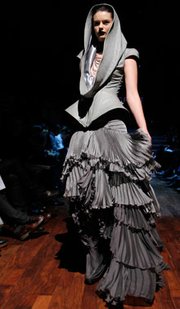The Evolution of Skingraft
When designer Jonny Cota debuted his Spring 2011 Skingraft collection recently at Los Angeles Fashion Week, the Los Angeles–based line had a renewed focus that refined the look of the theatrical and edgy 5-year-old collection.
The line was already in influential stores such as Church in Los Angeles and Oak in New York. With the Spring collection, Skingraft was picked up for the first time by Opening Ceremony and Isetan in Tokyo, Atrium in New York, and H. Lorenzo in Los Angeles.
H. Lorenzo selected the collection as one of three lines representing the Los Angeles retailer on the runway at Beverly Hills Fashion Festival (see related story here).
“We’re quite known for finding designers before they make it or hit it more mainstream,” said Leran Hadar, store director of the Los Angeles–based retailer (and son of founder Lorenzo Hadar). “We like the [Skingraft] aesthetic—it works with our aesthetic. It made sense in the store. I thought it was quite creative what they do.”
H. Lorenzo is known for its fashion-savvy clientele and cutting-edge selection of European and Japanese brands such as Comme des Garccedil;ons, Junya Watanabe, Ann Demeulemeester, Haider Ackermann and Damir Doma. Structure meets silk chiffon
This season, Cota focused on making the collection more accessible to a wider range of customers. And he refined the aesthetic to give the collection a higher-end look.
Those who know Skingraft from the Los Angeles Fashion Week runways have seen the line’s early beginnings, which included the extravagant couture pieces and gowns embellished with feathers and studs.
Spring has transitioned into an edgy yet sophisticated streamlined look. The buttery leather pieces remain part of the collection—as do the custom couture pieces (as well as bridal gowns). But the primary focus these days is on the ready-to-wear. The latest collection includes structured leather jackets, silk chiffon harem pants, oversized jersey cardigans and avant-garde silk gowns. Wholesale prices range from $30 or $45 for bamboo and jersey items up to $400 or $500 for leather pieces.
For Spring, the collection was inspired by African tribal body modifications—neck rings, stretched earlobes and tattoos. A stylish nod to Grace Jones kept the look modern and sci-fi. Cota updated the collection this season by utilizing fabrics such as jersey, bamboo and silk chiffon for the first time. “I think it lightened up a lot of the looks. It gave it a softness, which we didn’t have in the past,” he said.
The designer said he also made a conscious decision to make the clothes more wearable without losing Skingraft’s high-end structured leather aesthetic. “We always do really form-fitting leather pieces. That’s great, but it fits 10 percent of the population. So instead of making bigger sizes, we just did more things that were drapey or relaxed or could fit different body types,” he explained.
The collection also gleans some of its influence from Bali, where 90 percent of it is produced. Cota spends a third of the year there along with many designers from around the world who set up camp to create their collections.
The availability of certain materials on the island influences the types of materials that are used in the Skingraft collection. For example, all of the leather pieces are made from sheepskin because the island’s primary religious base is Hindu, which considers cows sacred.
In addition, the island is filled with villages where artisans specialize in local crafts such as bone carving, knitting or silversmithing. Cota is able to create a unique look for Skingraft by printing fabrics, sanding leather and casting closures.
Bali also has a creative influence. “It’s a beautiful, beautiful place that focuses a ton of energy on spirits and gods and deities,” he said. “It’s incredibly religious and incredibly gentle. Even if I’m going there with hard urban-city designs, no matter what, they are softened up there—because you can’t go into the middle of the jungle and make a really hard future city look. You just can’t. It brings an organicness to it.”Going solo
In October, Skingraft debuted the Spring collection in a group show sponsored by Cotton Inc. at the Exchange L.A., a nightclub in the former Los Angeles Stock Exchange building in downtown Los Angeles.
For many in the audience, it was the first look of Skingraft created solely under Cota’s design direction. Cota said he didn’t immediately know how important this collection was for him. “I didn’t realize until the day of the show that this was the first collection that I really designed from the ground up without partners, without any collaborators,” he said. “So I think that my aesthetic really came through this time. [I] also just learned for the first time what my aesthetic is,” he said.
Cota originally launched the brand with partner Cassidy Haley. The pair met during a stint with El Circo, an underground circus based in San Francisco. Soon, they moved to Los Angeles and launched Skingraft. Self-taught and with no budget, they began making leather jackets out of recycled leather garments from Goodwill. Katie Kay joined the brand in 2008, and the three collaborated on the collection for several seasons and then opened a flagship store on Fourth Street between Spring and Main streets in downtown Los Angeles.
According to Cota, the store has been instrumental in the brand’s success. “It gave us a bricks-and-mortar focal point where people could see the designs,” he said. “It also put our name in the vocabulary of L.A. fashion.” The store provides a glimpse into the Skingraft world. Taxidermy hangs from the walls, leather jackets line the racks and couture gowns are on display in the windows. Customers can shop from the line at retail. And with the design studio based in the back of the store, stylists are easily able to pull from the collection.
The brand’s theatrical appeal has made it a “go to” for celebs including the Black-Eyed Peas, Fergie, Rihanna, Kat Von D, Juliette Lewis and Adam Lambert, who wore Skingraft on his recent tour.
Late last year, Haley moved on to pursue other creative projects. Kay followed in March 2010. “Each of my partners no longer had the desire to move forward in the direction that Skingraft was going,” Cota explained. “So, they’ve all branched off to do other things.”
Following their departure, Cota’s brother Chris joined the company as business manager and partner. “We are a great team. He handles all the business, and I do all the creative,” Jonny Cota said. “It’s perfect. I couldn’t ask for a better situation.”Next up: color
As Skingraft gears for the future, Cota plans to continue to evolve the brand’s aesthetic. “I have this list every season of something that really needs to be taken on for the season,” he explained. This season the focus was on wearability and reinventing the men’s collection. Next season, he plans to introduce color. “How do we make our designs and make the aesthetic of the company just as enchanting and just as haunting by using color?” Cota said. “I always want to feel challenged each season, and the challenge right now is just going past black,” he said.
Cota also plans to continue to upgrade fabrics and materials—something that hasn’t been a focal point in the past. “I think that when we really upgrade those things, the designs will be really, really polished,” he explained.
Other plans include stepping up wholesale sales, expanding internationally and possibly showing at New York Fashion Week. “I think that we’re ready,” Cota said. “I think that we’ve matured a lot in the last year, especially with the store. It’s made us really grow up. I feel really empowered and really fiery right now to go take that on,” he said.



























